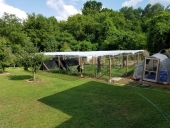
 5
5




Other people may reject you but if you lie in the forest floor for long enough the moss and fungi will accept you as one of their own!
 1
1




Dennis Bangham wrote:I went crazy and completely covered my backyard in wood chips. Tired of maintaining grass and wanting to make the yard more productive for veggies and fruit.
- Cool!
I have several fruit trees that I am maintaining to under 15 feet. Several Asian Pears, Asian Persimmons, Pluots/Plums, Apples. The pergola will have a 50% shade cloth in the summer and I will grow kiwi (Fuzzy and Hardy).
The black shelters are where I hold my mushroom logs. I will move all of them behind the white metal building.
BUT
I would like suggestions. What to plant on the wood chips or should I wait a year? Maybe white clover to keep the chips in place during rains. Are there any interesting/useful ideas on what I can do between the trees? I like things that do not require fertilizer/insecticides/etc.
- you should be able to plant most anything as long as you pull the chips back where you are planting and gradually pull them back towards the plants as they grow.
I found something called Orach (Mountain Spinach) which grows 6 feet tall. Sounds worth trying.
I will need to leave a path big enough for a small compact tractor to haul chips in. How often do I renew the chips? Ever other year but for how long? Afraid to smother my fruit tree roots by burying them too deep.
- I would not worry about smothering the roots, the trees should love it. When you put the chips around the tree, do not pack them high around the trunk. Just a couple inches at the base of
the tree and angle them up from there to your finished depth. If you put them deep at the trunk you can induce some diseases.
I live in North Alabama so it is long hot humid Summers and seemingly shorter Spring/Fall and Winter is getting shorter and shorter but still cold around 15F. My soil is a loam on top and clay around 1 or 2 foot down followed by boulders. These pictures are facing due east. The soil should be phenomenal in a year or so.
Would appreciate ideas that will continue to improve the soil, attract pollinators and of course feed the family/neighbors.
- Look at some of Daron's great suggestions in his recent posts on perennials.
Sincerely,
Ralph




Sincerely,
Ralph






 1
1




Other people may reject you but if you lie in the forest floor for long enough the moss and fungi will accept you as one of their own!





Striving to grow things as naturally, simply, and cheaply as possible! 
My YouTube channel










Other people may reject you but if you lie in the forest floor for long enough the moss and fungi will accept you as one of their own!














Other people may reject you but if you lie in the forest floor for long enough the moss and fungi will accept you as one of their own!
 1
1




Dennis Bangham wrote:I just put down straight chips. It is around 4 to 6 inches deep and after it settles I might put more.
I was thinking of putting a ring of hardware cloth around the base of each tree. Leave 3 to 4 inches clear all around and pile up the chips around the net.
I am hoping this will keep weeds down around the base and still allow a lot of moisture retention and fungal growth. I am seeing a lot of naturally occuring fungi in the chips as I moved them since they sat for 6 to 8 months.
I can get as many chips as I can handle but it is getting harder and harder on the muscles to haul them up the hill in a wheelbarrow so I will sweet talk the hunny into getting a small tractor and front end loader to play with.
Myrth
https://ello.co/myrthcowgirl












Moderator, Treatment Free Beekeepers group on Facebook.
https://www.facebook.com/groups/treatmentfreebeekeepers/















Other people may reject you but if you lie in the forest floor for long enough the moss and fungi will accept you as one of their own!




Terceira Island, Azores in Portugal.
Im a lover of nature.
Follow my garden on Instagram!
@CynefinGarden






 2
2




Other people may reject you but if you lie in the forest floor for long enough the moss and fungi will accept you as one of their own!

|
Anything worth doing well is worth doing poorly first. Just look at this tiny ad:
The new permaculture playing cards kickstarter is now live!
https://www.kickstarter.com/projects/paulwheaton/garden-cards
|


